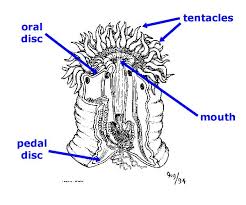| mfnmac053.naturkundemuseum-berlin.de See the crab's eye stalks? |
One of the first classes I took when I went back to school was Biology 101. That was 1978, and I still remember how the professor opened the class. He told a gee-whiz biology story, and I’ve been hooked ever since.
It was an example of a symbiotic relationship between two unrelated organisms—in this case a hermit crab and a sea anemone. A symbiotic relationship is one that is often, but not always beneficial to each organism. Sea anemones, which are related to coral and sea fans, are usually found attached to rocks. Hermit crabs, on the other hand, scuttle about wearing someone else’s abandoned shell.
| itsnature.org |
Sidebar:
| ocean.nationalgeographic.com |
A Symbiotic relationship is a close association of animals or plants of different species that is often, but not always, of mutual benefit
Mutualism advantageous relationship between species: a relationship between two organisms of different species that benefits both and harms neither. For example, lichens are a fungus and an alga living in mutualism: The fungus provides a protective structure, and the alga produces a carbohydrate as food for the fungus. The relationship between the hermit crab and the sea anemone is likely mutualism.
.
Commensalism is symbiosis between unrelated organisms: the relationship between organisms of two different species in which one derives food or other benefits from the association while the other remains unharmed and unaffected.
Sea anemones are named after the terrestrial flower because they look like flowers, but they are meat eating animals. Anemones have a central mouth surrounded by tentacles with stinging cells, called nematocysts, that entangle and paralyze small marine animals that drift into reach of its tentacles. They do have some mobility, moving a few inches an hour.
My professor told how the hermit crab, using its little pinchers, teases an anemone off a rock, then lifts and places it on its shell. It needs to be gentle and careful not to arouse the anemones defenses.(I think there is a YouTube of everything. I couldn't believe I found this one of an anemone eating a hermit crab.) http://www.youtube.com/watch?v=by1S-kZ4gN4
AND
another of a hermit crab acquiring an anemone
Postscript: I have to take my computer in for maintenance and will be offline for a week or so.
Once suitably situated, my professor told us, the hermit crab feeds itself by plucking bits and pieces of this and that from the rocks, but every so often, it tosses a little something up to the anemone. A true symbiotic relationship: the hermit crab wears a hat of stinging tentacles; the sea anemone gets fed on a regular basis. And who knows, maybe it enjoys the faster pace, waving its tentacles joyfully at its grounded cousins as its busy little ride trundles about.
Phylum: Cnidaria
Class: Anthozoa
Order: Actiniaria

Class: Anthozoa
Order: Actiniaria
Learn more: http://en.wikipedia.org/wiki/Sea_anemone
Postscript: I have to take my computer in for maintenance and will be offline for a week or so.
No comments:
Post a Comment
Note: Only a member of this blog may post a comment.